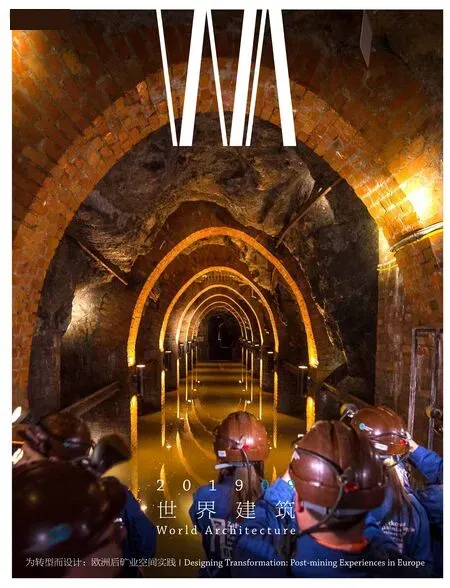在设计中生存
2019-10-17何塞普玛利亚加西亚丰特斯JosepMariaGarciaFuentes
何塞普-玛利亚·加西亚-丰特斯/Josep-Maria Garcia-Fuentes
朱琳 译/Translated by ZHU Lin
记忆与再生:胡安·纳瓦罗·巴尔德维格作品中身体与记忆
栏目主持:阿尔伯托·博洛尼亚,米凯利·博尼诺,皮埃尔-阿兰·克罗塞特
胡安·纳瓦罗·巴尔德维格(1939 年生于西班牙桑坦德)的作品和形象并不为中国大众所熟知,因此,我们希望在《世界建筑》杂志“记忆与再生”栏目中的发表能够帮助人们更好地了解他。如何能用几句话刻画出他的独特和在当代建筑的国际视野中的重要性呢?
首先,50 多年来,纳瓦罗·巴尔德维格将他作为建筑师的工作与其作为画家和雕塑家的工作联系起来,并且在全部3 个领域都有着出色的成就,包括各类奖项、出版,以及在西班牙乃至全欧洲、还有美国最重要的博物馆和文化中心举行个人人类学展览。
其次,其密集而又丰富的建筑和艺术作品中展现出了非凡的一致性和连续性,并聚焦于一些激进的想法和观念:对重力、光线、身体、时间和装饰品的实验。这种当下十分罕见的一致性并不限制研究领域。相反,多亏了广泛的阅读——从艺术史到人类学,从精神分析到生物学,(甚至)从中国诗歌到美学——所滋养的求知欲,也多亏了遥远的建筑师和艺术家之间——比如约翰·索恩和理查德·诺伊特拉,亨利·马蒂斯和马塞尔·杜尚——彼此呼应的格外广泛而开放的视觉文化,纳瓦罗·巴尔德维格得以继续深化和丰富他的工作,并达到了如今最成熟的程度,正如后文发表的巴塞罗那庞培法布拉大学项目(1996-2016)中所彰显的那样。
在这一典型的方案中,3 座新建筑唤起了之前存在的建筑体块,并维持了它们的体量和高度,但同时在材料、色彩和创新的内部空间上又有了根本的区别,为城市地区的再生做出了决定性的贡献。因此,“记忆”的概念作为纳瓦罗·巴尔德维格作品的核心,与“变形”的概念是分不开的,这可以从以前的经典作品中得到证明,例如穆尔西亚旧磨坊的重建(1984-1987)、马德里大圣弗朗西斯科大教堂地区的规划(1982-1994),特别是罗马的赫兹图书馆(1995-2012):一个非同寻常的阶梯状空间围绕着由玻璃围成的采光井,能够唤起该区域丰富的历史分层——曾经的罗马别墅花园和后来的16 世纪祖卡利宫花园。
纳瓦罗·巴尔德维格的作品不仅体现了场所和建筑的记忆和变形,也体现了主题和图案的记忆和变形,例如,他能够将一些书法符号变形并植入庞培法布拉大学对彩色遮阳的绝妙而灵活的运用:绘画和涂鸦的手部动作的记忆被镌刻在遮阳这一建筑元素的物质性中。然而,一切都是以微妙的、几乎超然的方式发生的:艺术家-建筑师的身体及其创作的时间在作品中的存在仍然是谨慎的、几乎抽象的,因此我们必须用我们的身体去体会空间体验全部的丰富性和多样性。简而言之,纳瓦罗·巴尔德维格提出将整个建筑定义为“一种身体的艺术”,因为我们的身体“像一个敏感的接收器和中介,在物理世界中自由地移动和互动”,正因如此,建筑的目的“是引导对自然环境的创造性关注,来有意地呈现出预先存在的东西——它先于任何特定的工作目标而存在”[1]。 (皮埃尔-阿兰·克罗塞特)
Memory and Regeneration: Body and Memory in the Work of Juan Navarro Baldeweg
Column Editors: Alberto Bologna, Michele Bonino, Pierre-Alain Croset
The work and the figure of Juan Navarro Baldeweg (Santander, Spain, 1939) are little known to the Chinese public, and we hope therefore that this publication on the pages of the "Memory and Regeneration" column of World Architecture would contribute to a better knowledge of him.How to characterise in just a few lines what makes him unique and so important in the international panorama of contemporary architecture?
Firstly, for over 50 years, Navarro Baldeweg has associated his work as an architect with that of a painter and a sculptor, with very high levels of excellence in all three fields, recognised by prizes,publications and personal anthological exhibitions in the most important museums and cultural centres in Spain, Europe and the United States.
Secondly, there is an extraordinary coherence and continuity of this intense and rich production,both architecturally and artistically, which focuses on a few radical ideas and notions: experimentation on the gravity, on light, on the body, on time, on the ornament. This coherence, so rare today, does not limit the field of research. On the contrary, thanks to an intellectual curiosity nourished by readings ranging from art history to anthropology, frompsychoanalysis to biology, from (even) Chinese poetry to esthetics, and thanks to a particularly wide and open visual culture that echoes architects and artists very distant from each other - such as John Soane and Richard Neutra, Henri Matisse and Marcel Duchamp - Navarro Baldeweg continues to deepen and enrich his work that reaches today its greatest degree of maturity, evident in the project for the Universitat Pompeu Fabra in Barcelona(1996-2016), published on these pages.
In this exemplary intervention, the three new buildings evoke the pre-existing volumes maintaining their mass and height, but at the same time radically differentiate themselves in the materials, colours and innovative internal spatiality,contributing decisively to the regeneration of the urban area. The notion of memory, central to the work of Navarro Baldeweg, cannot therefore be separated from that of metamorphosis, as evidenced by previous exemplary interventions such as, for example, the restructuring of the Old Mills in Murcia (1984-1987), the arrangement of the area of San Francisco el Grande in Madrid (1982-1994),and especially the Hertzian Library in Rome (1995-2012), an extraordinary terraced space that wraps around a well of light with a glass perimetre, able to evoke the rich historical stratification of the area, once the garden of a Roman villa and later the garden of the sixteenth-century Palazzo Zuccari.
Memory and metamorphosis not only of places and buildings, but also of themes and motifs,characterise the work of Navarro Baldeweg, able for example to transfigure some calligraphic signs in the wonderful plastic invention of the coloured sunbreakers of the Universitat Pompeu Fabra: the memory of the gesture of the hand that draws and scribbles is engraved in the materiality of this architectural element. However, everything takes place in a subtle, almost detached way: the presence in the work of the artist-architect's body and of its creation's time remains discreet, almost abstract, and so we with our body have to live the spatial experience in all its richness and variety. In a nutshell, Navarro Baldeweg proposes to define the whole architecture "an art of the body", because our body acts "like a sensitive receiver and agent, freely moving and interacting with in the physical world",and for this reason the purpose of architecture"is to direct the creative regard on the natural environment to deliberately render present the preexisting, that which is prior to any specific work objectives" [1]. (Pierre-Alain Croset)
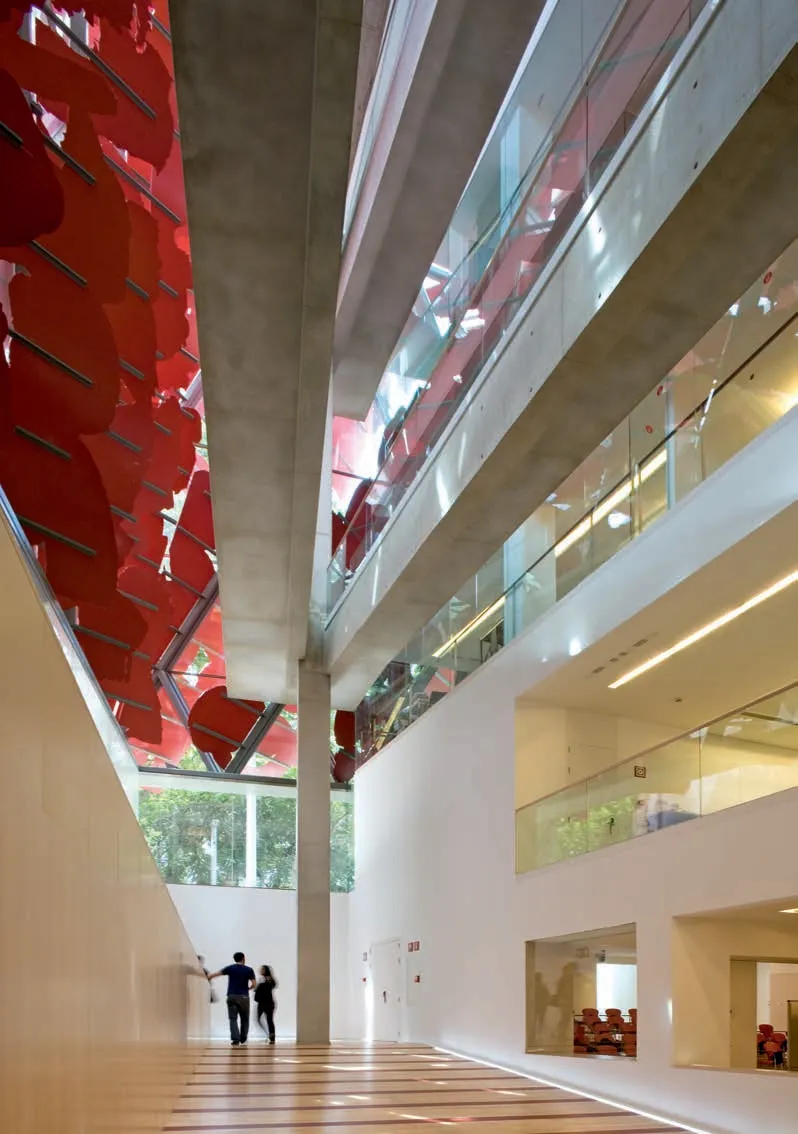
1 胡安·纳瓦罗·巴尔德维格设计的红色庭院的内部大厅/The interior hall in the red courtyard by Juan Navarro Baldeweg(图片来源/Sources: Lourdes Jansana)
纳瓦罗·巴尔德维格特意设计了3 座不同的建筑——它们看起来很简洁,且都与场地边界对齐。严整的立面由白色、银色和灰色构成。然而,3 座建筑的材料稍有不同:玻璃,铝材和混凝土;每座建筑暗含的建构和结构对策也稍有不同:其中一个是纯玻璃立面,一个是由带切口的铝板包裹,还有一个好似在立面上露出了内部的混凝土网格。尽管它们分别展现了不同的构成元素,它们成功地创造出一种富有多样性的整体感。

2 新建筑面向休塔德利亚公园/Façade elevation of the new buildings towards the Ciutadella Park
3 座建筑之间的空间形成了两个庭院,将正对休塔德利亚公园的地块南侧与新建筑和原有军营之间的步行街连接起来。一个薄薄的体块在高层将其中两座建筑连在一起。它沿着步行街,尽管相对建筑立面稍稍缩进,但它在这一侧确定了属于这两座建筑的连续体量,并且所有的入口都布置在此侧。这个体量为整体引入了一种微妙的不对称感。它包括了交通空间,两侧分别连接了两座建筑的大堂,从而扩展了它们各自的公共空间,同时建立起与步行街对面的主校区的某种关系。一座露天连桥将新建筑与由军营改造而来的主校区上的教学空间连接起来。
3 座建筑的大厅和交通空间垂直展开,沿着新的建筑体块的剖面,布置在两个庭院周围,它们可以为小型阶梯教室和每座建筑地下层的其他小教室等公共空间提供光照,通风和朝向公园的视野。如果说院系空间和办公室的朴素风格是关乎城市肌理和场所记忆的一种背景,相对地,丰富的空间形式探索被浓缩在了这些庭院中,包括连接从地下层到顶层所有楼层的垂直空间,还有透明玻璃构成的倾斜曲面立面。
此外,两个庭院的构成元素所呈现特别的多彩面貌,并显示出极大的自由,与3 个体块整体的朴素亦不加粉饰的材料性之间形成一种张力。每个庭院中巧妙的色彩元素,不仅为阳光直射最多的立面部分充当遮阳,同时也激活了新建筑的大厅和公共空间,并在这些垂直空间中创造出令人兴奋的体验。这些色彩元素是经过激光切割的大型铝板。在其中一个庭院,这些铝板被切割成建筑师的画笔笔迹的形状,并涂成红色。另外一个庭院的铝板有着近似菱形的切口,涂成绿色。这些美妙的色彩本身是互补色,因此同时相对于新建筑主要立面上不加粉饰的混凝土和玻璃的材料特性,增添了一种充满活力的对应。
纳瓦罗·巴尔德维格在这些建筑中的材料和设计的构图使人想起胡安·米罗的著名画作——画家在粗糙的画布上随意地布置一系列手画的线条,绳结和明亮的彩色织物元素。于是,整个构图就是一套简单元素,被极其省力的方法结合起来,以创造出富有启发性和表现力的作品。同样地,这也是建筑师在这个项目中所实现的,并呼应着场所记忆和场地的独特性。比如,其中一个庭院的红色铝板是固定在立面的结构上的,一半在建筑内部,一半在外部。这模糊了室内外的边界,并且当阳光照在巨大的铝板上,会形成像森林中的树叶所形成的影子那样独特的阴影。忽然之间,建筑的使用者会透过一个窗口注意到街对面与之互补的绿色公园,而这一窗口正是基于这一目的而精心设置的。
建筑师对于米罗式构图的借鉴清晰地体现在了位于马略卡的一个会议厅竞赛的提案中,上文提到的很多想法都在这个项目中得到了进一步的发展。这种洞察力显露出了建筑师对于将“互补的几何形”应用于设计的探索,还有对类似于“挂毯中的图案”“网中的结”“共鸣的盒子”(其中“建筑只是乐器,音乐才是最重要的”)等建筑形式的反思。这些想法从巴尔德维格早期在麻省理工大学与捷尔吉·科普斯合作时起,就奠定了他的作品——正如现有与纳瓦罗·巴尔德维格相关的出版物所广泛认同的那样。
然而,除了这些想法之外,庞培法布拉大学的项目还展现出巴尔德维格为了克服现代艺术,科学和建筑之间特有的分裂而进行的踏实探索。确实,如果说大多数现代建筑师在专注于探索由新的材料和建造技术——机器——的应用所形成的所有挑战,现代艺术家则更倾向于重新思考人类的根本是什么,艺术的心理学影响如何,以及技术可以怎样传递我们最直接的感知。当巴尔德维格试图在他的建筑中调和这些明显的相悖的探索,这种张力就在其作品中得到了升华。这也提示我们铭记理查德·诺伊特拉的观点。与这位美国建筑师一样,巴尔德维格在巴塞罗那的这一项目使我们想起了技术与建筑在调和我们与自然和建成环境的关系中所起到的作用。作为人类,我们和我们的城市,只有通过设计才能够继续生存并保持鲜活的记忆,因为建筑使衰退的城市文脉重获新生,并不断赋予它新的含义。□

3 在这三座建筑物中,纳瓦罗·巴尔德维格针对每个建筑物的不同立面解决方案和材料的细部/Details of the different façades solutions and materialities in each of the three buildings by Navarro Baldeweg(2.3图片来源/Sources: Eugeni Bach)
The Universitat Pompeu Fabra was founded in 1990 with the aim of establishing a brand-new world-leading academic and research institution in the city of Barcelona. The goals and legal aspects for the creation of the new institution were inspired by those of the Universidad Carlos III, which was founded one year earlier in Madrid. The project for the new Barcelonan public university had an intense ambition to build a robust relationship with Catalan society. It was agreed that the academic and research focus of the new university would focus on the areas connecting human beings with the urban polis:social sciences and humanities, biomedical sciences,and technology of communications.
Enric Argullol, a jurist and C hair in Administrative Law, led the first steps of the project following a commission by the Catalan Government,and eventually became the first rector of the institution. The task to regenerate the academic and research life of the country with values of excellence and internationalisation set the ambitious agenda of the new institution, and the challenge to solve its urban and architectural location was turned into an opportunity to focus the ambition of building a strong social commitment with the city of Barcelona.
Instead of building a new campus, the new university was "inserted in the middle of the old city of Barcelona, where, like in many other old European urban centres, degradation was not a risk, but unfortunately a reality", as explained by Argullol. The original master plan of the university was thus conceptualised as means to foster a wider urban regeneration. It contemplated the use of a few closed-off buildings scattered in the old city,including abandoned palaces and ruined hotels elements, and manage to create a consistent set enlivened by diversity.
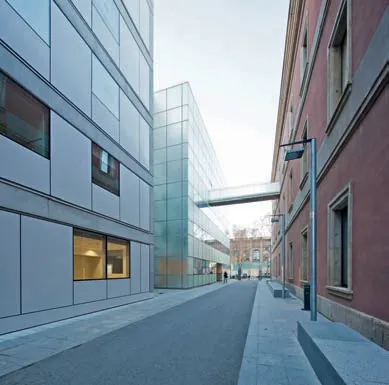
4 新建筑与前圣若梅军营的主校园空间(位于右侧)之间的步行街/The pedestrian street between the new buildings and the main campus space in the former barrack of Sant Jaume (on the right)(图片来源/Sources: Eugeni Bach)
The spaces between the three buildings define two courtyards connecting the south-facing side of the site, that in front of the Ciutadella Park, to the pedestrian street that runs between the new constructions and the former barrack. One thin volume connects together two of the three buildings in the upper floors. It is placed along the pedestrian street, though slightly indented in regards to the buildings' façades. However, it defines a continuous mass for the two buildings on this side, where all entrances to each building are positioned. This volume introduces a subtle asymmetry into the whole set. It contains circulation spaces and sews together the halls of the two buildings on each side,as it expands the public areas of each building, and also establishes a relation to the campus buildings placed across the pedestrian street. An open-air bridge links the new departments with the teaching spaces in the main campus area -the former barrack.
The halls and circulations areas of the three buildings are developed vertically, across the section of the new volumes, and organised around the two courtyards, as they supply light, ventilation and views towards the park to the common and public areas, including a small lecture theatre and other small teaching rooms placed in the basement of each building. In contrast to the austerity of the departmental spaces and offices, which act as a sort of background connecting with the urban fabric and the memories of the site, rich spatial exploration is concentrated in these courtyards, with vertical spaces running past all floors from the basement to the top, and slanted and curved façades of transparent glass.
Moreover, constructive elements in these two courtyards have a special colourful presence that manifests with an intense freedom, in tension with the austere and raw materiality of the whole building mass of the new three volumes. These brilliant colourful elements in each courtyard act as solar protections for the façades most exposed to sunlight, as they also animate halls and public areas of the new buildings, and create an exciting experience in these vertical spaces. They are big lasercut aluminium plates. In one courtyard these sheets are cut to the shape of the architect's ink-brush scrawls and painted red. In the other courtyard the plates are perforated with cuts in rhomboidal shapes, and the aluminium is painted green. These brilliant colours, therefore, are complementary,located next to Las Ramblas, in the historic quarter of the city, but also other unusual constructions like a former water tank which was transformed into the central library of the university. The reuse of this last building, located in front of the Ciutadella Park, was envisaged in connection to two adjacent blocks of military barracks, which were transformed into the university's main campus area. Actually, the whole area of the park itself was also a military place before it became a park during the World Fair held in the city in 1888, when the space was gained as a new public area for the city.
The project for the Universitat Pompeu Fabra by architect Juan Navarro Baldeweg sits within these successful interventions. It consists of a set of three connected buildings that are the outcome of a restricted competition for the whole site organised in 1996. Since then, the construction of the project has spanned over two decades, until the completion of the last building in 2016. The site is a large rectangular plot with one of its long sides facing the former barracks, earlier transformed into the main campus area. The other long flank, facing south, is open towards the green park of the Ciutadella.
The competition brief defined the details of the programme in the new buildings - department offices and spaces linked to the main campus area in the former barrack of Jaume I - and the massing of the area. Architects were required to demolish the three existing housing blocks on the site (which were raised in 1888 to serve for the barracks in front)due to their poor original construction and design.It was stipulated that all proposals must organise their built mass in three volumes while keeping the same height above ground as the existing buildings,so the new development could somehow keep part of the site's memory. At a more practical level: this tripartite division would allow the organisation of the construction work in clear stages, to be executed when funding becomes available.
Navarro Baldeweg deliberately designed three different buildings for the site that appear simple and align with the plot edges. They have discreet façades in white, silver and grey colours.Their materiality, however, differs slightly for each building: glass, aluminium and concrete; as does the underlying tectonic and structural solution for each volume: one is defined as a clean glass façade, another is wrapped in an aluminium sheet perforated with openings, and the last one seems to reveal its inner concrete grid in the elevation. All of them, though, manifest their respective constructive and they add a vibrant counterpoint to the palette materiality of untreated concrete and glass in the main surfaces of the new volumes.
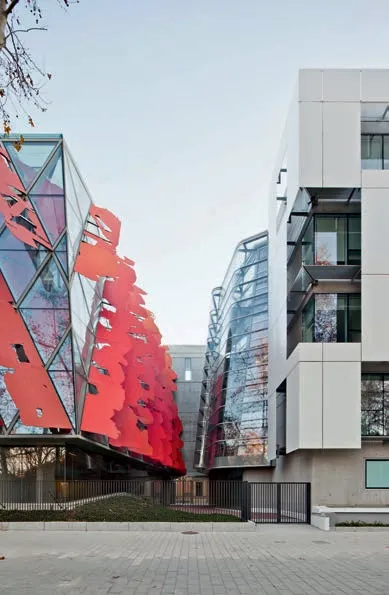
5 红色庭院与围绕其的垂直交通空间和大厅/The red courtyard and the vertical circulation spaces and halls around it
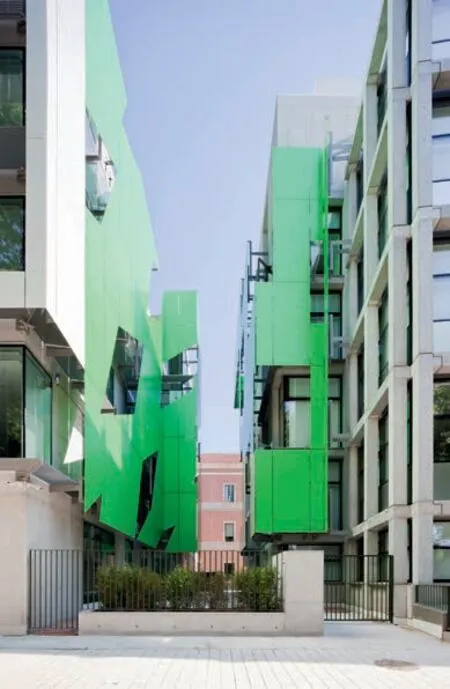
6 大学的院系大楼与帕斯夸尔·马拉加利基金会(位于右侧)之间的绿色庭院/The green courtyard between the university's department buildings and the Fundació Pasqual Maragall (on the right)
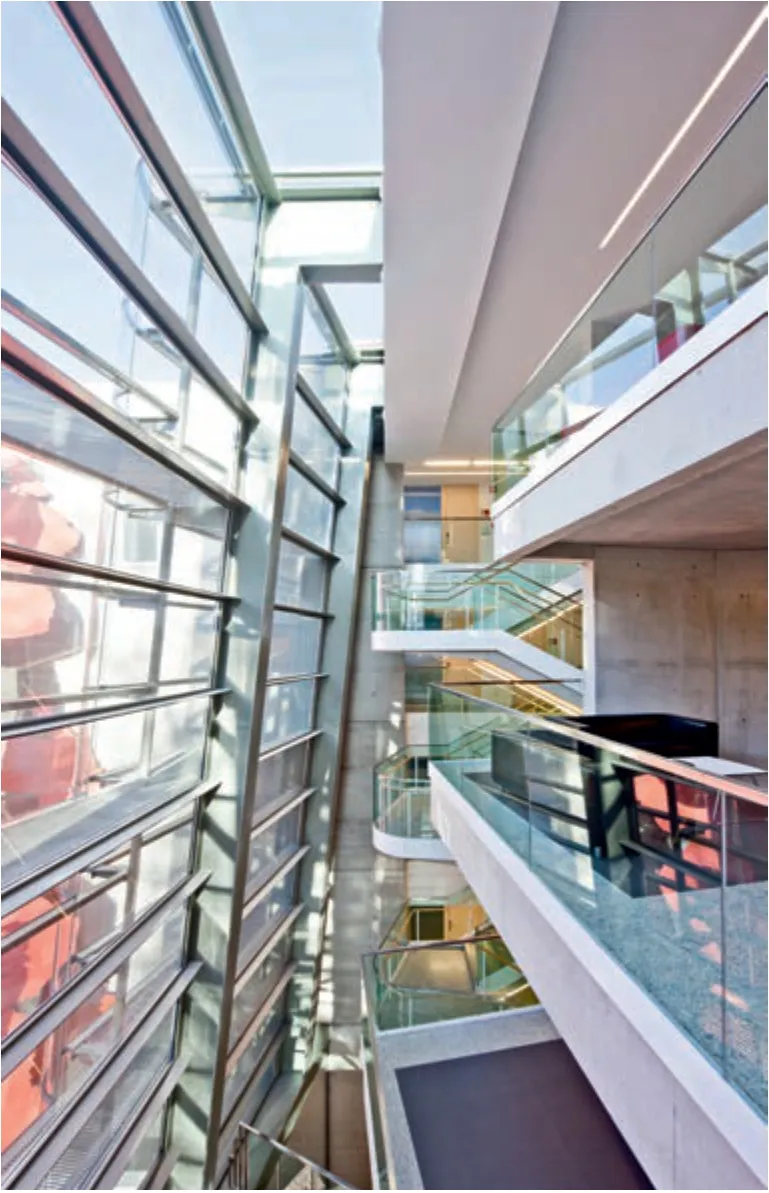
7 中央大楼的红色庭院面向交通空间/The circulation spaces facing the red courtyard in the central building
The material and design composition by Navarro Baldeweg in these buildings evokes the famous paintings by Joan Miró, in which the painter casually articulates a series of hand-brushed lines,rope knots and bright coloured fabric elements upon a crude canvas. The whole composition is thus a set of simple elements joined together with an extreme economy of means to create an evocative and strong expressive piece. Similarly, this is what the architect achieves in his project in relation to the memories of the place and the site's uniqueness. The red aluminium plates in one of the courtyards, for example, are fixed upon the structure of the façade,with half of their surface inside the building and half of it outside. This blurs the boundary between interior and exterior, and when sunlight hits the big plates, it casts a distinctive shadow that resembles that cast in a forest by the leaves of trees. Suddenly the user of the building becomes aware of the complementary green park across the street, which the view can reach through a window carefully placed with this aim.
The reference to Miró's compositions is explicit in the architect's report for the competition on a conference hall in Mallorca, a project in which many of these ideas are developed further. This insight reveals the architect's constant exploration of design through "complementary geometries",as well as his reflection on architecture like "the image in the tapestry" "the knot in a web", or a"box of resonance" in which "architecture is the instrument, but what matters is the music." Ideas that underpin the architect's work since his early stages at the MIT together with György Kepes, as is widely acknowledged in the existing bibliography on Navarro Baldeweg.
Beyond these ideas, however, the project for the Universitat Pompeu Fabra reveals Baldeweg's steady search to overcome the entrenched split between art, science and architecture of modernity. Indeed,if most modern architects concentrated in exploring the boundaries of the challenges posed by the use of new materials and constructive techniques -the machine- modern artists were rather inclined to rethink what is the organic essence of humankind,the psychological impacts of art, and how technique might mediate our most immediate perception.This tension is sublimated in Baldweg's work, as he tries to reconcile all these apparently divergent explorations into his architecture. This also prompts us to remember the ideas of Richard Neutra. Like the American architect, the project by Navarro Baldeweg in Barcelona reminds us of the role that technology and architecture play in mediating our relation with nature and the built environment. It is only through design that we, as human beings, and our cities, will survive and will keep memories alive as architecture regenerates degraded urban fabrics and continuously mediates their interpretation.□
注释/Note
1)Restricted competition,即指对参赛者身份有所限制的竞赛。
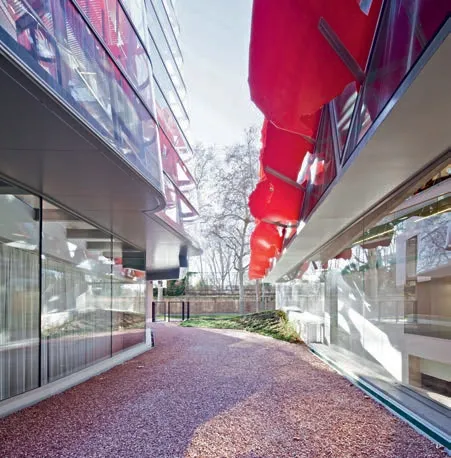
8 红色庭院的地面花园朝向休塔德利亚公园/The ground garden in the red courtyard looking towards the Ciutadella park(图片来源/Sources: Eugeni Bach)

9 大学的建筑物在旧城中的分布,贫困区域得到了重建/University's buildings in the old city and deprived areas to be regenerated(图片来源/Sources: Universitat Pompeu Fabra)

10 南立面/South elevation(图片来源/Sources: Juan Navarro Baldeweg)

11 首层平面/Ground floor plan(图片来源/Sources: Juan Navarro Baldeweg)A-庞培法布拉大学,梅尔塞·罗杜莱拉楼,惠灵顿38号/Universitat Pompeu Fabra, Mercè Rodoreda Building, Wellington 38 B-庞培法布拉大学,社会科学与人文馆,惠灵顿32-36号/Universitat Pompeu Fabra, Social Sciences and Humanities, Wellington 32-36 C-帕斯夸尔·马拉加利基金会,惠灵顿28-30号/Pasqual Margall Foundation, Wellington 32-36
